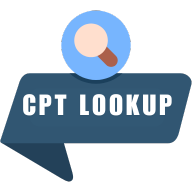CPT Code Lookup Tool
Use this free CPT Lookup Tool to search for Current Procedural Terminology (CPT) codes, descriptions, and related details — designed to help streamline and simplify your medical billing process.
Enter a CPT code or keyword to search
Search Results
Office or other outpatient visit
Evaluation and management of an established patient...
Information
This code is for use in medical billing and coding.
Information
This code is part of the section of CPT codes.
Office or other outpatient visit for the evaluation and management...
Note
This description reflects the 2021 E/M coding guidelines.
Information
codes are used to report evaluation and management services provided in various settings.
Information
RVUs are used to determine the fee for a service under the Medicare Physician Fee Schedule.
Information
This code is commonly used by primary care providers, but may be used by any specialty providing office visits.
Significant, separately identifiable E/M service
Information
Modifiers provide additional information about the service provided.
Detail About CPT 99210
CPT Code 99210: Established Patient, Level 1 Office or Other Outpatient Visit
What the Procedure Involves
CPT code 99210 is used to report an established patient office or other outpatient visit that requires a problem-focused evaluation and management (E/M) service. This code is typically used for brief visits that involve minimal complexity. The visit may include a limited examination and straightforward medical decision-making. It is often used for minor issues or follow-up visits where the patient's condition is stable and requires minimal intervention.
When It's Typically Used
CPT 99210 is typically used in situations where the patient presents with a minor problem or complaint that requires minimal evaluation and management. Examples include follow-up visits for chronic conditions that are well-controlled, such as hypertension or diabetes, where the patient is stable and requires only routine monitoring and prescription refills. It is also used for visits where the physician or healthcare provider addresses a single, uncomplicated issue.
Documentation Requirements
To support the use of CPT 99210, documentation should include the reason for the visit, a brief history of the present illness or problem, any pertinent examination findings, and the medical decision-making process. The documentation should clearly reflect that the encounter was problem-focused and of low complexity. It is important to note that the time spent with the patient is generally minimal and should be documented if it is a significant factor in the visit.
Billing Guidelines and Considerations
Billing for CPT 99210 requires that the visit meets the criteria for a Level 1 E/M service. This includes a problem-focused history, a problem-focused examination, and straightforward medical decision-making. It is important to ensure that the documentation supports the level of service billed. Overbilling or underbilling can lead to audits and potential penalties. Additionally, this code is often reimbursed at a lower rate compared to higher-level E/M codes, reflecting the minimal complexity and time involved.
Common Scenarios and Examples
Common scenarios for using CPT 99210 include a follow-up visit for a patient with controlled hypertension who needs a prescription refill, a brief visit to discuss lab results that require no change in management, or a visit to address a minor skin rash that requires minimal treatment. These visits are typically short and involve straightforward decision-making.
Related Codes
For more complex visits, consider using related codes such as [CPT 99211](/tool/cpt/99211) for a nurse visit, [CPT 99212](/tool/cpt/99212) for a slightly more complex established patient visit, or [CPT 99213](/tool/cpt/99213) for a moderate complexity visit. Each of these codes reflects increasing levels of complexity and time spent with the patient.
Tips for Proper Coding
1. Ensure documentation accurately reflects the level of service provided. Avoid upcoding or downcoding by matching the documentation to the appropriate CPT code.
2. Familiarize yourself with payer-specific guidelines, as some insurers may have specific requirements for billing CPT 99210.
3. Use this code judiciously, as it is intended for minimal complexity visits. For more complex cases, consider using higher-level E/M codes.
4. Regularly review and update your knowledge of coding guidelines and changes to ensure compliance and accurate billing.
By understanding the appropriate use and documentation requirements for CPT 99210, healthcare professionals can ensure accurate billing and compliance with coding standards.
Add CPT Lookup to Your Desktop
Install this free AI tool on your desktop for quick access to accurate CPT codes anytime.

